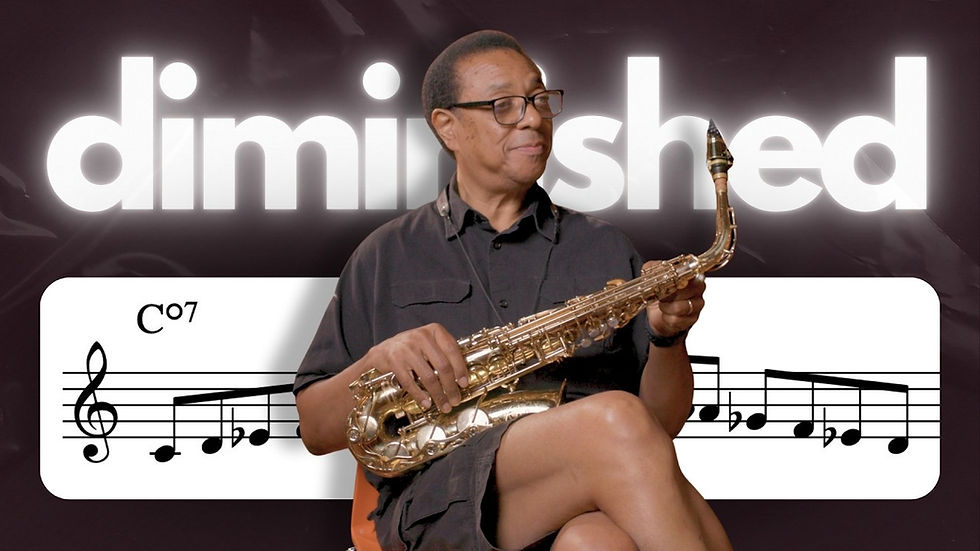The Only Scales You Need to Know For Jazz Improvisation
- Jazz Lesson Videos

- Aug 5, 2022
- 4 min read
Today we’re going to check out every scale you’ll ever need to know for jazz improvisation. Believe it or not, there aren’t that many. We’ve narrowed it down to the 18 most essential scales and we’ll be checking out a few of them today.
We will be talking about all of these scales from a common root because it’s an important way to practice them, and it’ll provide continuity as we look at what notes are different in each scale.
In the full Scales For Jazz Improvisation PDF, all 18 scales are written in all 12 keys and there are 4 vital scale exercises for truly getting these scales under your fingers and in your ears. If you feel like diving deeper on your own, here’s a link: DOWNLOAD RESOURCE>>>
Let’s dive in and take a look at the first 6 scales!
These are the most common scales that you’ll want to get under your fingers first and we’ll be looking at 5 different chords they can be played over.
1: The Major Scale: I'm sure most of you will recognize this one. It is the major scale played over the major seventh chord (Maj7).
C Major Scale played over a C Major 7 chord.
2 The Dominant Scale: This scale can be played over the dominant seventh chord (7). You’ll also see this scale referred to as the Mixolydian Scale. While it’s great to understand modes of scales, it’s more effective to think about the scale as it is in terms of how it’s built.
C Dominant Scale played over a C Dominant 7 chord.
With modes, you’re always thinking of a scale in relation to another scale. For instance, with Mixolydian, you’d be thinking that's the scale starting on the fifth degree of the major scale, then I want to start and stop my scale on this fifth degree, etc.. It becomes too much of an equation to figure out while you're improvising. You want to only know the scales on their own to make your improvising more fluent. The best way to practice this is to understand them from a common root. That's one of the reasons why the Scales For Jazz Improvisation PDF is structured the way it is. This allows a reference of what notes change between each scale. This PDF resource has the Jazz Chord Scales Master List plus 4 scale exercises in all 12 keys for a total of 446 pages of content: DOWNLOAD RESOURCE>>>
Dorian is going to be the most common minor scale we use over a minor 7 chord. There are a couple of alternatives we will check out later but, for now, this is the most commonly used option.
C Minor Scale played over a C Minor 7 chord.
Now that we have a strong foundation of our 3 most common chords (Major 7, Dominant 7, and Minor 7), let’s dive into some scales which are not as well known, but are equally important. Over the half diminished seventh chord, there are two scale options. We can either suggest the ♭9 or the ♮9 in our scale and this will determine the variation of the scale we play. Some people say to do one and some say to do the other. Both are great options, but it depends on what flavor you want to hear over the chord.
For the scale with the ♭9 , we're going to label it as Locrian. For the scale with the ♮9, we’re going to label it as Locrian ♮2 or Locrian ♮9. All of the other scale notes are the same.
Locrian Scale played over a Half Diminished 7 chord.
Locrian Natural 9 Scale played over a Half Diminished 7 chord.
Our sixth scale is the last of the most common scales out of the 18 essential scales for jazz improvisation.
The diminished scale, which is built on the intervals of repeated whole steps and half steps, is the best option for playing over the fully diminished seventh chord that we frequently encounter in jazz standards. We’ve all skated over this chord at some point in our improvisation development!
For example, a diminished seventh chord leads into a iii - vi- ii - V progression in jazz standards. So it's really important to get that sound down.
We always get stuck playing the one, flat three, flat five, and six, which you can also think of as a double flat seven.
Now that we have the chord tones down, let’s check out the rest of the notes that are part of this chord scale. As we mentioned, this scale is built on the intervals of repeated whole steps and half steps. So we start on the Root, go up a whole step to the 9, go up a half step to the flat 3, go up a whole step to the four, go up a half step to the flat 5, and keep repeating this whole step and half step movement until we reach the octave above.
Whole/Half Diminished Scale played over a C Diminished 7 chord.
Congrats! You successfully learned the six most essential scales for jazz improvisation. There are twelve other scales that we didn’t get to, but will learn in the next Scales For Jazz Improvisation post. For the Jazz Scales Master List and the Scales Exercises in all 12 keys visit this link: DOWNLOAD RESOURCE>>>









Comments